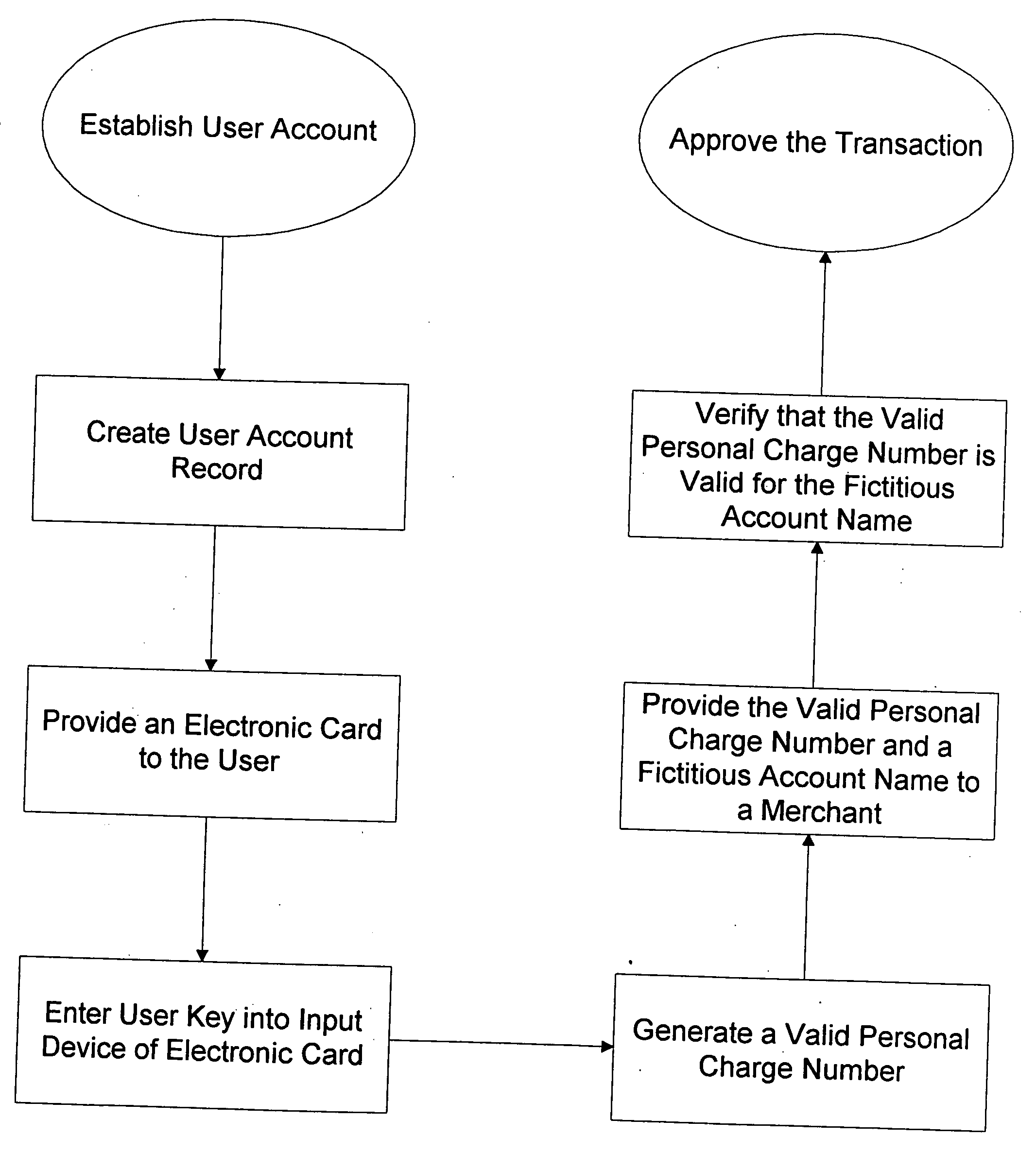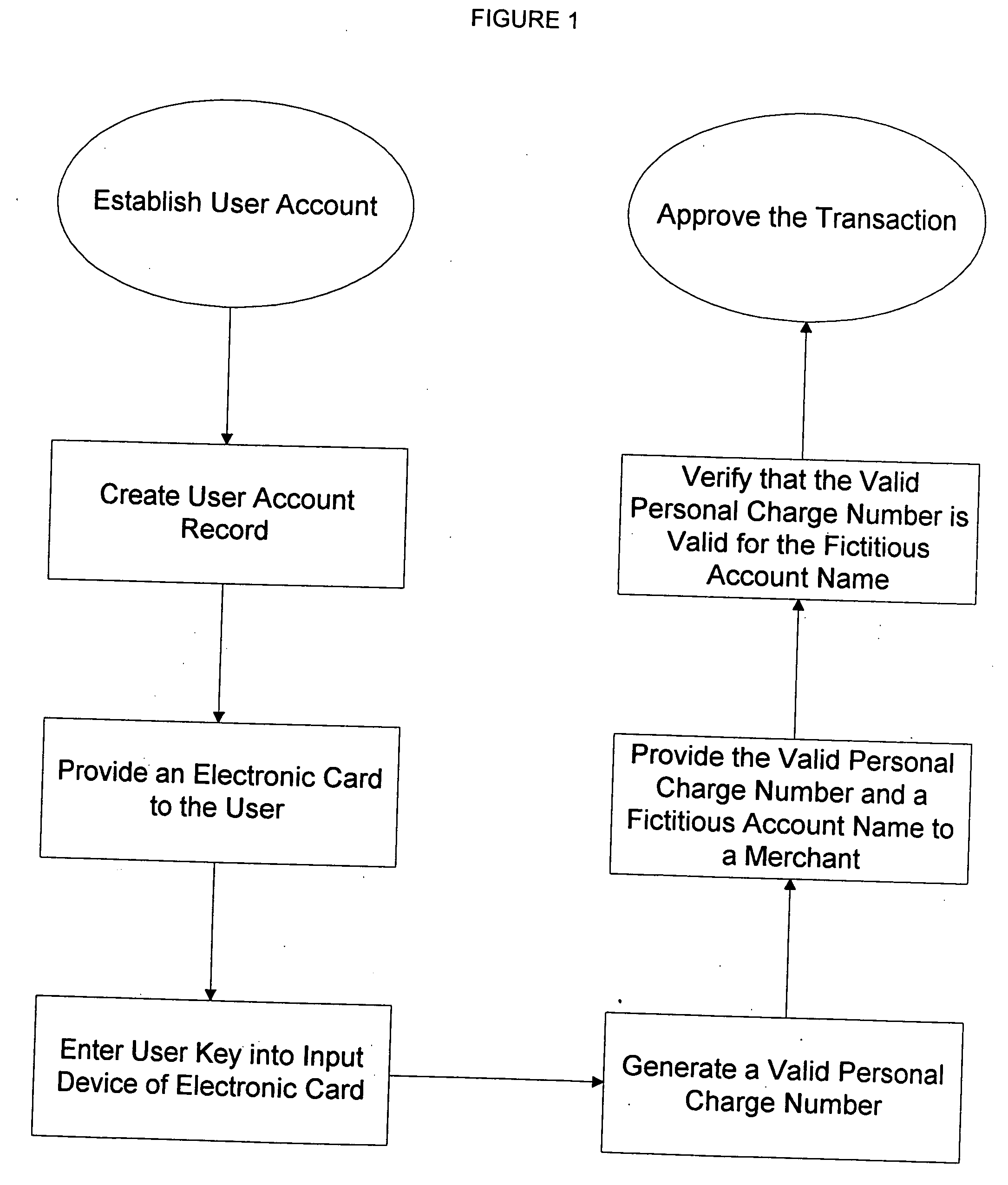Although consumers generally face little financial risk because federal law caps
consumer liability for unauthorized charges on credit cards at $50, the loss to merchants and card issuers is far more significant and amounts to hundreds of millions of dollars per year.
While the prior art is replete with various and diverse secured or even smart credit card systems,
credit card fraud is still a serious and widespread problem.
This is because many attempts to provide a smart, secure credit card
system in the past have proven to be too complex and user-unfriendly, and this is believed why such cards, with the exception of American Express' Smart or Blue Card (see below), have not gained user acceptance.
While the methodology advanced at the time was indeed novel in its capability of eliminating unauthorized or fraudulent use other than by the card owner, it suffered nonetheless from a number of major drawbacks.
First and foremost is the complexity of the
system itself.
The instructions of how to use the credit card alone are a major burden to card owners in order to ready the card for even a simple routine transaction.
In other words, the credit card
system is extremely user-unfriendly.
Such a requirement of additional equipment further complicates the utility and elevates the already expensive components cost of the system.
Third, the system is incompatible with existing credit card transaction infrastructure and merchants who opt to use such a system must invest in new and expensive equipment in order to reap the system benefits.
Consequently, such a credit card system has not achieved a widespread level of acceptance and usage by the general public.
Again, the complexity of such a system, together with its inherent incompatibility with the existing credit card transaction infrastructure, has proved to be too much of a barrier for the system to be widely accepted and implemented by the financial
community.
While the card can serve multiple functions, it still suffers from several drawbacks that prevent it from being widely accepted by the general public, including its complexity in use, its innate incompatibility with existing credit card transaction infrastructure and the
resultant high cost of operating such a system.
Although such a credit card system has the ability to help prevent unauthorized or fraudulent use, it is unlikely that this system will be widely accepted in the financial
community because of its
operational complexity from the user's standpoint, and its questionable compatibility with the prevalent credit card transaction infrastructure.
This credit card system is, by design, rather complicated.
Thus, the user's identification
verification is by no means a simple procedure.
Without even raising the issue of the questionable public acceptance today with regards to using
fingerprint imaging as a form of personal identity, the procedures the card user must endure in order to safeguard the card's security against unauthorized usage are far too complicated.
Thus, the
verification number used in one given transaction will not be useful in a subsequent transaction.
Therefore, even if someone were to see the
verification number used in one transaction, they would not be able to use it in a subsequent transaction.
However, such a methodology still has drawbacks.
One drawback is that crucial information pertaining to the
card holder and the
encryption algorithm resident in the memory of the resident
microprocessor on the card are not immune from discovery by modern day electronic piracy.
Because the credit account number and the verification number generated for each transaction are both visibly made available to the merchant so they can be sent to a remote
processing center for subsequent
authorization, once the contents of a card is illegally obtained, there is no way to safeguard against subsequent large scale fraud.
Another drawback is that transmittal of the encrypted verification number, which is an
alphanumeric number comprising 14 or more characters, rather than a 4-decimal character PIN, along with the user identifying credit card number, might not be compatible with existing credit card transaction infrastructure.
In the real world, this represents a major roadblock for whether or not such a system will be accepted by the financial
community.
Even though the PIN is unique for each transaction, there is nothing to stop anyone in possession of a stolen card from sequentially generating the right combination of the PIN and account number, even though it might take some time to successfully carry out an unauthorized transaction.
Furthermore, it is operationally questionable whether or not the method taught in U.S. Pat. No. 5,627,355 (Rahman et al.) is actually scaleable.
The same worry also applies to occasional but unavoidable system glitches when such a huge quantity of numbers has to be reconciled.
At first glance the programmable transaction card advanced in U.S. Pat. No. 5,955,961 (Wallerstein) has packed away too many features in it so as to render it rather cumbersome and complicated to use, expensive to implement and user-unfriendly.
Inclusion of such an
inductor on the transaction card will certainly make it bulkier, and it is questionable whether it is actually compatible with most magnetic strip readers which read data via swiping the magnetic strip through a static reader head.
Also, incorporation of the feature of being able to select from a plurality of different accounts necessitates the use of an awkward
thumb-wheel switch on the card, which is less user-friendly.
The same applies to the situation when tonal identifying controls are added to the card, which will certainly make the latter even more bulky.
Furthermore, it is questionable whether credit card users would even know or appreciate how to use the tonal identification features of this transaction card.
Technically speaking, the use of a time-varying
magnetic field to transfer information encoded on the transaction card to a conventional magnetic stripe reader is highly risky and certainly represents a big deviation from the normal magnetic data transfer interface.
When all these extra but not necessarily useful features (at least for most ordinary credit card holders) are incorporated into this transaction card, such a card will be much more complicated and less friendly to use.
However, such
encryption requires special equipment provided to the cardholder.
And, despite heavy promotional and advertisement expenditures, the SmartCard system has not yet been well received in the United States.
However, nearly all of the systems proposed to date are either too complicated, tending toward overkill in some cases, or user-unfriendly, or too costly to implement or simply incompatible with existing credit card transaction infrastructure.
In addition, there has been a failure to recognize, much less address, issues of privacy or
anonymity associated with the use of credit cards in general.
While consumers are protected from large financial losses that may occur through Internet
credit card fraud, they are not protected from potential loss of
consumer personal privacy while doing business on
the Internet.
 Login to View More
Login to View More  Login to View More
Login to View More 

